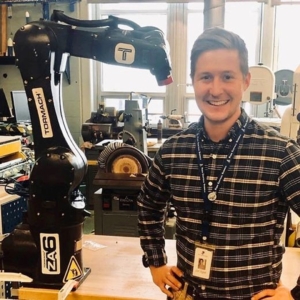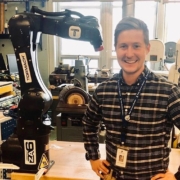Tech education teaching robotics
Tormach, headquartered in Madison, Wisconsin, supplies affordable and compact computer numerical control (CNC) machines. Their team wrote the following.
When launching our first robotic arm, the ZA6, we knew it was important to consider cost and ease of use. The ZA6 can handle a six-kilogram (13-pound) payload, yet programming is easy enough to learn in a matter of hours. Not weeks, or even months.
Changing tasks flexibly isn’t a thing most robots do well. Tormach’s engineers saw that as an opportunity and a challenge. How can a robot be made that’s so easy to manipulate, it can be used as a functional training tool in career and technical education (CTE)?
The power of programming language
The ZA6 uses Python as its programming language. Python is popular, easy to learn and powerful. And it’s easy to integrate ZA6 with other Python-driven systems. Tormach builds the ZA6 robot to industrial standards, utilizing EtherCAT servo motors, harmonic gear drives and aluminum castings. It can carry a payload through a reach of 975 millimeters with impressive speed and repeatability. Requiring only 20 amps of single-phase 220V, it can be installed almost anywhere.
PathPilot control software powers the ZA6. That features an intuitive user interface and powerful programming capabilities. No expertise in industrial robotics is required to program the ZA6 in most applications — on Tormach mills, lathes, routers and plasma tables. Tormach provides resources like a YouTube tutorial series, user forums and technical support.
Real-world industrial applications
 A Wisconsin-based concrete company was an early adopter of the ZA6. And they attest to starting up quickly with PathPilot and its use of Python. The production supervisor wanted to reduce the number of hours involved in welding copies of the same concrete form. He described this task as “monotonous.”
A Wisconsin-based concrete company was an early adopter of the ZA6. And they attest to starting up quickly with PathPilot and its use of Python. The production supervisor wanted to reduce the number of hours involved in welding copies of the same concrete form. He described this task as “monotonous.”
After setting up the ZA6 for welding, they used their existing metal inert gas (MIG) welder to create a welding cell. The ZA6 can make tens of thousands of copies of that single component. And this frees up staff to be productive elsewhere on more challenging welding applications. This kind of problem-solving demonstrates the kind of thinking CTE educators want to impart to students.
“The new ZA6 robot is a natural addition to Tormach’s product line,” said Andrew Grevstad, Tormach’s business development director. “Like our CNC mills, lathes, plasma tables and routers, it is designed for ease of use. It is perfect for educators and is available at an attractive price point.”
Classroom benefits
In real classroom environments, the possibility of programming a robot quickly and easily means students can focus more on robotics concepts and capabilities. Teachers have seen success with students setting up a program in as little as 25 minutes. STEM education can benefit in many ways. Because the ZA6 uses Python as its programming language, the integrations available throughout the Internet of Things are vast.




